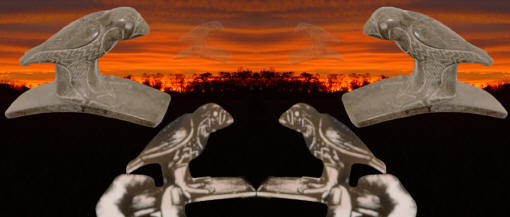|
"----in the construction and ornament of
their pipes, the Mound-builders seem to have expended their utmost skill
in sculpture."---1848,
E. G. Squire, A.M. and E. H. Davis, M.D., "Ancient Monuments Of The
Mississippi Valley," p. 243.
"The tobacco pipe of the Hopewell culture have a
distinctive form known archaeologically as the platform type."----1930,
Henry Clyde Shetrone,
"The Mound Builders," p. 162.
"The most important find
(the Mound City platform pipe cache)
comprised upwards of two hundred stone tobacco pipes, many of which were
fashioned in the images of birds, animals, and the human head."---1930,
Henry Clyde Shetrone, "The Mound Builders," pp. 213-214.
"Some of these sculptures
(the Mound City pipes)
have a value, so far as ethnological research is concerned, much higher
than they can claim as mere works of art."----1848,
E. G. Squire, A.M. and E. H. Davis, M.D., "Ancient Monuments Of The
Mississippi Valley," p. 242.
"-----the
remains (platform pipes from Mound
city) were so much broken up by the
action of the fire (cremation),
that it has been found impossible to fully restore them, although the
utmost care was expended in collecting the fragments."---1848,
E. G. Squire, A.M. and E. H. Davis, M.D., "Ancient Monuments Of The
Mississippi Valley," p. 243.
"Despite their efforts to arouse sufficient
interest in the United States to take this collection (the
Mound City cache of platform pipes)
off their hands at a price which would reimburse them for their
financial outlay, they were unsuccessful. The collection was taken
abroad, and is now owned by the Blackmore Museum of Salisbury, England
(now owned by the British Museum)"---1930,
Henry Clyde Shetrone, "The Mound Builders," pp. 23-24.

TREMPER & MOUND CITY
PLATFORM PIPES
ROSS & SCIOTO COUNTIES, OHIO
HOPEWELL CULTURE
When considering the early history of American archaeology the image of
Thomas Jefferson comes to mind and his excavation of an ancient mound.
But the first and single most impressive event is the publication of
Squire and Davis's "Ancient Monuments of the Mississippi Valley" in
1848. Their book describes, for the first time, a very large number of
ancient and complex earthworks in the form of mounds and embankments. Shetrone excitedly writes in 1930 that, "In the year 1848 the world
awoke to find on its doorstep what has come to be the great classic of
American archaeology, "Ancient Monuments of the Mississippi Valley" by
E. G. Squire and E. H. Davis." Their publication left little doubt that
America had an ancient past and these mysterious people were highly
skilled in engineering and the manufacture of fine art crafts.
|
|
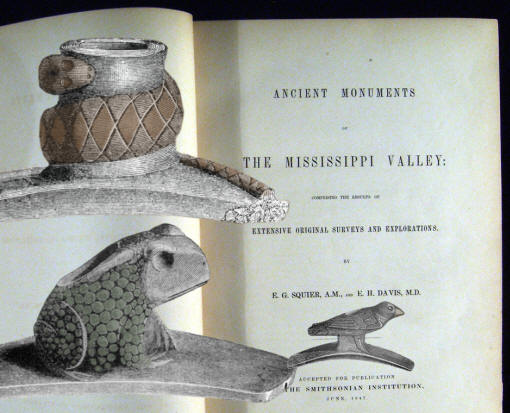
ILLUSTRATIONS FROM 1848 "ANCIENT
MONUMENTS OF THE MISSISSIPPI VALLEY"
SQUIRE & DAVIS'S
"ANCIENT MONUMENTS OF THE MISSISSIPPI VALLEY"
This is the first book printed by the Smithsonian Institution. It
was published in 1848. Shetrone writes in 1930 that "Through this
monumental production, issued as the first volume of the now long
series of publications of the Smithsonian Institution, public
interest for the first time was definitely and sharply focused on
the subject of the Mound-builders and their works." Squire and Davis
were the first to publish detailed drawings of
a large number of ancient and complex earthworks in the eastern
United States. They also illustrate many of the artifacts they
excavated from some of these sites. Ephraim G. Squire was editor of
the "Chillicothe Gazette," and his partner Edwin H. Davis was a
Chillicothe area physician. |
|
|
The art described in Squire and Davis's 1848 publication is
mainly in the form of Hopewell platform effigy pipes. At that time very
few people believed that an ancient culture who once lived in the
eastern United States would have been capable of sculpting such amazing
works of art that so precisely capture the image of nature. These are
the Mound City pipes. |
|
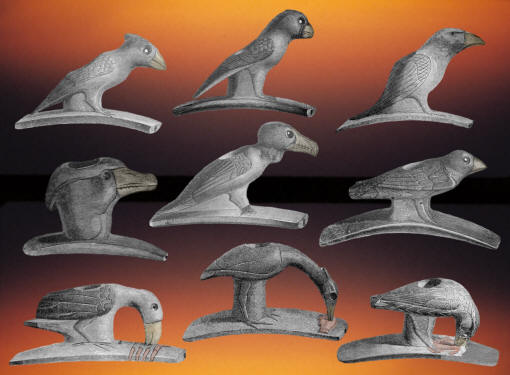
ILLUSTRATIONS FROM 1848 "ANCIENT
MONUMENTS OF THE MISSISSIPPI VALLEY"
CLICK ON PICTURE FOR LARGER IMAGE
BIRD EFFIGY PLATFORM PIPES
MOUND CITY SITE
ROSS COUNTY, OHIO
These
exquisite drawings show several of the Mound City effigy pipes that
were published in 1848 in Squire and Davis's "Ancient Monuments of
the Mississippi Valley." Birds seem to have been the most important
subject for the Hopewell craftsmen. Squire and Davis
wrote that, "The sculptures of birds are much more numerous than
those of animals, and comprise between thirty and forty different
kinds, and not far from one hundred different specimens." The
different kinds of birds represented in the cache are eagle, hawk,
heron, owl, buzzard, raven, swallow, parakeet, ducks and grouse.
Note that the three birds in the bottom row are shown eating or
pecking some type of food. The heron in the center is obviously in
the process of eating a fish. These types of action figures in
Hopewell pipes are much more rare than most figures that are in a
simple pose. Also note that at least two of the birds in this
picture seem to have their beaks sewn shut. The buzzard in the
center is the easiest to see. |
|
|
The Mound City pipes represent the first of two large caches
of Hopewell pipes that have been discovered to date. They were excavated
by Squire and Davis in 1846. The second large cache of pipes are the
Tremper Mound pipes. They were discovered in 1915 by William C. Mills
who supervised the excavation of Tremper Mound. Mills was also the
curator of the Ohio State Archaeological and Historical Society. |
|
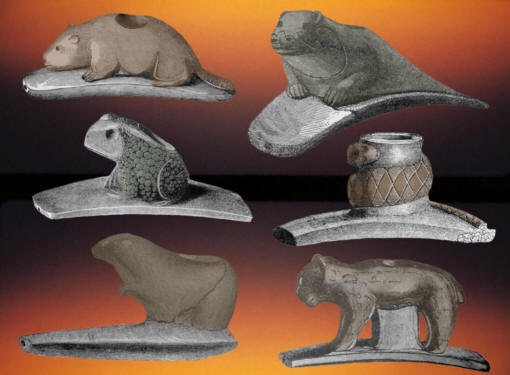
ILLUSTRATIONS FROM 1848 "ANCIENT
MONUMENTS OF THE MISSISSIPPI VALLEY"
CLICK ON PICTURE FOR LARGER IMAGE
ANIMAL EFFIGY PLATFORM
PIPES
MOUND CITY SITE
ROSS COUNTY, OHIO
These six drawings were used in Squire and Davis's book to
illustrate some of the better examples of mammal and reptile effigy
pipes. The picture shows a
beaver, frog, snake, otter and wild cat. The pipe at top right is
described by Squire and Davis as a manatee but there seems to be
some disagreement that it might be a beaver instead. |
|
|
The Mound City and Tremper Mound pipe caches date to the
Middle Woodland Hopewell period. The pipes would have been made sometime
between 100 B.C. and A.D. 500. Or sometime between 2,100 and 1,500 years
ago. |
|
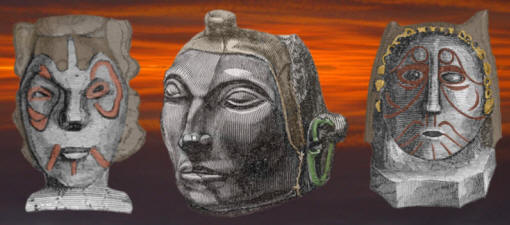
ILLUSTRATIONS FROM 1848 "ANCIENT
MONUMENTS OF THE MISSISSIPPI VALLEY"
CLICK ON PICTURE FOR LARGER IMAGE
HUMAN EFFIGY PLATFORM
PIPES
MOUND CITY SITE
ROSS COUNTY, OHIO
Perhaps the most important pipes found at Mound City are the human
effigy pipes. Although the Tremper collection didn't produce any,
the Mound City group includes four intricately carved and detailed
human heads. They are important because they record how the Hopewell
were decorating their faces, styling their hair, ornamenting their
ears and using different types of headdresses. Shetrone describes
the pipe at right as being, "one of the finest bits of Mound-builder
sculpture extant." He goes on to describe this pipe as, "Note the
haughty dignity of the face and the bonnet-like headdress. A chaplet
of pearls encircles the forehead, and incised lines probably
represent facial painting or tattooing." Mills describes the same
pipe as, "The features are boldly and strikingly executed, and the
face is adorned with incised lines, probably intended to represent
tattooing. A typical Hopewell headdress, with incipient antlers,
covers the head, while encircling the forehead and face is a row of
small freshwater pearls set into shallow cavities drilled into the
pipestone from which the specimen is made."
But it's interesting to note that Squire and Davis had a better
appreciation for the pipe in the center and described it as, "the
most beautiful head of the series." This is also the only human pipe
that was fully restored (see below).
The carved human head on the left is
the only example of the four that is not a pipe bowl. Squire and
Davis describes it's attachment point located "at the lower back
portion." The ears were also pierced and from the copper staining at
that location it's surmised that it once wore copper ear rings. |
|
|
Both the Mound City and Tremper Mound caches of pipes were badly
damaged. Much time and effort has been taken to restore a good number of
them. The Mound City pipes were damaged from a cremation fire as
Edwin A. Barber reports in 1882, "Many-----were much broken up, some of
them calcined by the heat, which had been sufficiently strong to melt
copper, masses of which were found fused together in the center of the
basin." The Tremper Mound pipes were also ritualistically damaged from a
process that left them thoroughly fragmented. They were found in a fired
clay crematory basin similar to the Mound City cache. Mills also
believed that some of the damage may have been caused from deliberate
breakage from a ritual that "killed" them prior to the interment. He reports
another example of ritual "killing" in Mound 13 at Mound City that
involves a cache of 5,000 shell beads. The beads were in a buckskin bag
that apparently had been repeatedly struck with a hammer (stone) until,
as he writes,"----the greater part of the contents were crushed and
broken." |
|
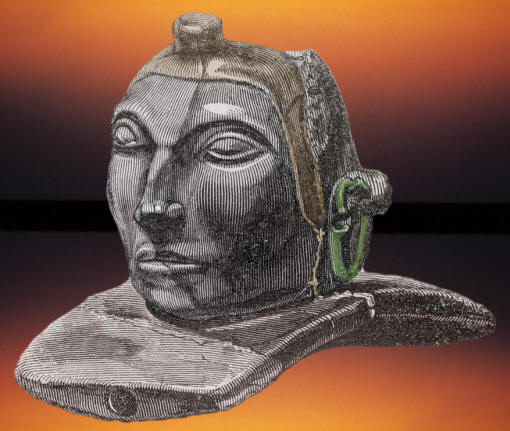
ILLUSTRATION FROM 1848 "ANCIENT
MONUMENTS OF THE MISSISSIPPI VALLEY"
CLICK ON PICTURE FOR LARGER IMAGE
HUMAN EFFIGY PLATFORM PIPE
MOUND CITY SITE
ROSS COUNTY, OHIO
Of the four human head effigy platform pipes excavated by Squire and
Davis this is the only completely restored example. It's also the
one that Squire and Davis liked the best, remarking that it's, "the
most beautiful head of the series." and they go on to say "The
workmanship of this head is unsurpassed by any specimen of ancient
American art which has fallen under the notice of the authors, not
excepting the best productions of Mexico and Peru. The whole is
smooth and well polished." The drawing also appears to have an ear
ring but it's not mentioned by Squire and Davis. |
|
|
It's difficult to know the exact number of pipes that were
discovered in the two great caches. But they did number in the hundreds.
The Mound City cache is usually given a number of 200 pipes. It's
reported that 95 of them are animal effigy pipes. The rest have the more
common round bowls of various heights and rim decoration. The Tremper
Mound pipes are reported to be about 136 in number with 60 of them carved in the
form of different types of animals common to the area at the time they
were made. The rest of the pipes were in the form of platform pipes with
plain round bowls and also some that were cigar-shaped tubular pipes. |
|
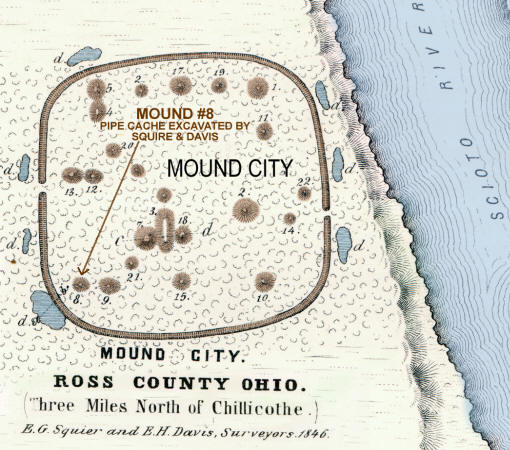
ILLUSTRATION FROM 1848 "ANCIENT
MONUMENTS OF THE MISSISSIPPI VALLEY"
CLICK ON PICTURE FOR FULL MAP
EARLY MAP
OF MOUND CITY SITE
FROM SQUIRE & DAVIS
HOPEWELL SITE
ROSS COUNTY, OHIO
This map of the Mound City
site was published in 1848 by Squire and Davis in "Ancient Monuments
of the Mississippi Valley." The Mound City site is located within 13 acres that is
surrounded by a rectangular low embankment. There are 23 mounds within
the enclosure. The site received its descriptive
name from its high concentration of mounds within such a small area. The
arrow shows the location of mound #8 where Squire and Davis
discovered the Mound City cache of 200 pipes. |
|
|
The Mound City and Tremper pipes are most famous for their accurately
carved sculptures of different kinds of bird, mammal, reptile and even human
effigy forms. The Tremper Mound effigy pipes were carved to represent
owls, hawks, ducks, cranes, quail, prairie chicken, crow, toads,
turtles, beaver, otter, mink, raccoon, rabbit, squirrel, porcupine,
possum, fox, wolf, bobcat, bear, mountain lion, dog and deer. |
|
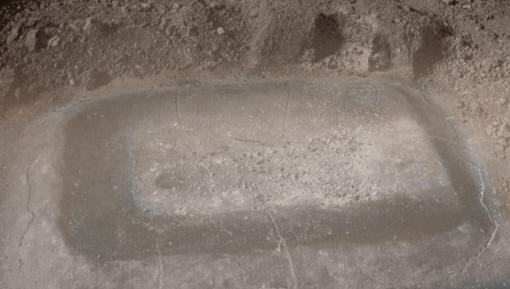
EXCAVATION FEATURE OF MOUND CITY
CACHE OF PLATFORM PIPES
MOUND CITY SITE
ROSS
COUNTY, OHIO
This picture shows the cremation feature in mound 8 on the Mound
City site where Squire and Davis discovered the large cache of
pipes. |
|
|
The Mound City cache
also contains a wide range of different kinds of bird, mammal and
reptile effigy pipes in the collection. Squire and Davis illustrated
several animal effigy pipes carved as beaver, otter, wild cat and elk.
They also show examples of reptiles in the form of frogs and a snake.
But the birds seem to have been the most important subject of the
craftsmen. Squire and Davis wrote that, "The sculptures of birds are
much more numerous than those of animals, and comprise between thirty
and forty different kinds, and not far from one hundred different
specimens." The different types of birds are represented as eagle, hawk,
heron, owl, buzzard, raven, swallow, parakeet, ducks and grouse. |
|
CONTINUE ON TO PAGE
TWO
|
|
"REFERENCES"
1848, Squire, E. G. and E. H. Davis, E. H., "Ancient Monuments Of
The Mississippi Valley," p. 242-268.
1882, Barber, Edwin A., "Mound Pipes," The American
Naturalist, Vol. XVI, April, pp. 265-268.
1930, Shetrone, Henry Clyde, "The Mound Builders," pp. 22-24, 122,
162-163, 194-195, 213-214.
1968, Silverberg, Robert, "Mound Builders of Ancient America,"
pp. 270-273.
2000, Romain, William F.,
"Mysteries of the Hopewell," pp. 38 & 209.
2004,
Penney, David W., "The Archaeology of Aesthetics," Hero
Hawk and Open Hand, p. 50.
2005, Lepper, Bradley T., "Ohio Archaeology," p. 126.
2005, Emerson, Thomas E., "Tremper Mound, Hopewell Catlinite and
PIMA Technology," Mid-Continental Journal of Archaeology, Vol. 30 No.
2, Fall.
Personal
Communications
with Dennis Vesper.
|
|
RECENT
LISTINGS HOME
ORDERING |
